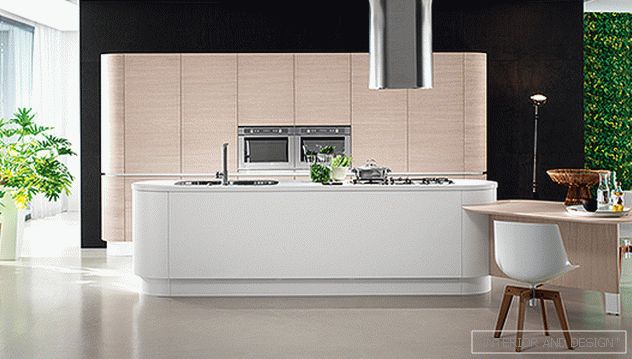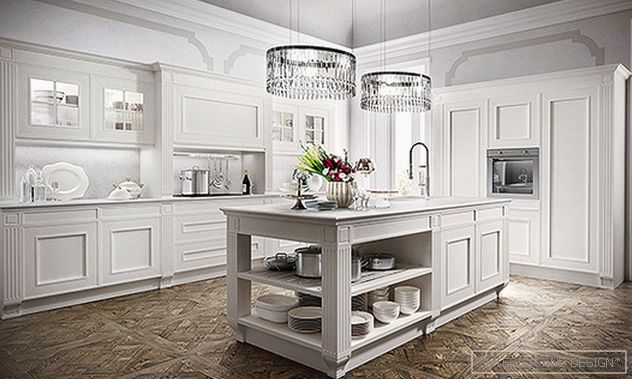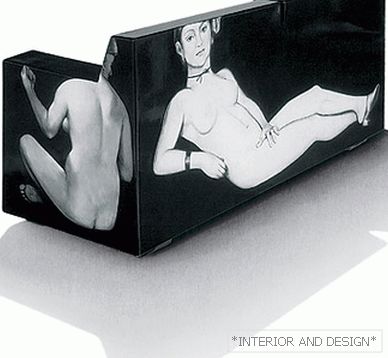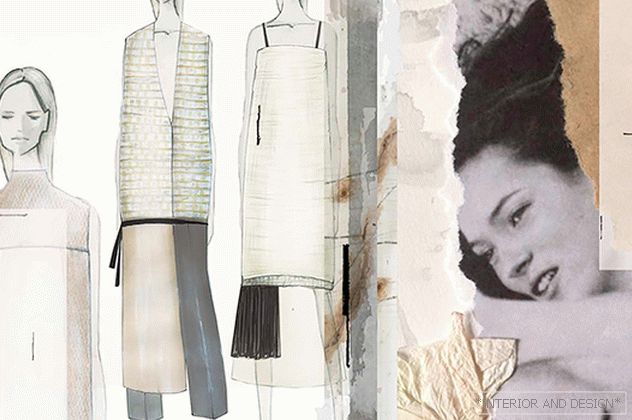The company Composit was founded in 1974 in the town of Montecchio Belligotti brothers and initially produced furniture for the house. However, 10 years later, she switched to top-end kitchens and relied on design. The move was successful. Today the main markets of the brand are Holland, France, Russia, Ukraine, Cyprus, England, Singapore, USA. The Belligotti subsidiary manufactures walk-in closets and luxury bedroom furniture. Says the commercial director of the factory Massimo Belligoti (Massimo Belligotti):
“Our trump cards: advanced design, advanced technology, a wide range of products. An important point: Composit is one of the few kitchen factories that make their own carcass and facades, while almost all other manufacturers only assemble models from finished components. This gives us freedom, the opportunity to deviate from the standard.
The range of our offers is wide. We have models for huge mansions and for small apartments. For young people who furnish their first housing, and for wealthy customers who dream of a prestigious status kitchen. For those who appreciate the classics and the warmth of natural wood, and those who are closer to modern lines, colors and materials. Such a strategy is possible in the presence of extensive multivolume catalogs with a detailed price list and a detailed description of each model and each type of decoration. The philosophy of Composit is focused on the production of kitchens that live and serve their owners for many years, we even introduced such an expression: “the kitchen of life”. Developing new collections, we pursue two main tasks: to take into account the changes occurring in society and in people's lifestyle, and in addition, to be confident in the absolute reliability of all materials used.
We work with the best designers. Roberto Lazzeroni, Piergiorgio Cazzaniga, duet Leone + Mazzari, Daniele Lo Scalzo Moscieri, Enrico Cesana - these are just some of the names. The design opens up new opportunities, brings our models to the highest level, while their price remains acceptable.
Our production process is based on 10 key concepts that contribute to environmental protection: air, energy, water, garbage, paper, packaging, materials, durability, paints, household appliances. Among the first Italian brands in 1997, Composit was certified according to the ISO 9001 quality standard, which adequately crowned the 20-year effort, and in 2008 - according to the new ISO 9007 standard. HPL- resistant to moisture and steam, impact and scratch (EN438); tempered glass doors in an aluminum frame (7142), bases for sinks in aluminum and stainless steel, moisture and fire resistant bases for refrigerators, brackets that can withstand loads up to 70 kg, and bases up to 650 kg; boxes with moisture resistant processing of internal surfaces; 1 V chipboard panels that are 100 percent moisture resistant. Since April 2008, we have been using Idroleb, the panel with the lowest formaldehyde emission in the world. ”
 Noisette is made in 4 matte or glossy lacquer colors: platinum, beige, chocolate and brown Chad. Also used American walnut, marble and quartz (4 grades to choose from), tempered glass with a reflective effect.
Noisette is made in 4 matte or glossy lacquer colors: platinum, beige, chocolate and brown Chad. Also used American walnut, marble and quartz (4 grades to choose from), tempered glass with a reflective effect. Model Noisette, created in conjunction with the designer Roberto Lazzeroni, according to company management, opens a new chapter in the history of Composit. “We call this style a modern classic,” says Massimo Belligotti. - There is nothing from futuristic delights and cold modernism - a comfortable beautiful kitchen in which it is pleasant to cook and live. At the heart are wonderful materials such as American walnut and maple in combination with glossy varnish and steel. Today, Noisette is one of our most successful models, and it is popular in Russia. ” The collection is created with attention to detail. Luxury finishes combined with visual ease and practical organization. Depending on the choice of color and material, different stylistic interpretation is possible.
 Touch attracts with a pure concise form, a combination of synthetic and natural materials. The island is covered with a composite composition resembling concrete.
Touch attracts with a pure concise form, a combination of synthetic and natural materials. The island is covered with a composite composition resembling concrete. The Touch program - the creation of Pierge Georges Cazzanigi - embodies the image of modern cuisine. Thin tabletops with integrated sinks are made of modern synthetic materials. It is proposed to combine the lacquer coating of the facades (43 matte shades and the same glossy ones) with wood (a choice of different tint oak, eben, walnut, rosewood). Top cabinets open vertically. Of particular praise in the project was the design of the handle: when it is not used, it can be recessed in the plane of the facade.
 The program Maxima offers 30 color matte varnishes and 11 gloss. Plus, natural oak and painted (6 shades), as well as rosewood, walnut, eben.
The program Maxima offers 30 color matte varnishes and 11 gloss. Plus, natural oak and painted (6 shades), as well as rosewood, walnut, eben. Maxima Piergiorgio Cazzanigi's cuisine is attractive for its vintage feel. The lines of the 70s are reinterpreted from the point of view of today: the kitchen is treated not only as a place where people cook, but also where they communicate, having a pleasant time. The central element is an island with a composite worktop with built-in sink and hob. There is a model of the correct form (in the photo), as well as a curved, resembling a boomerang. The program has a variety of finishes. In the composition in the photo, the white lacquer of the island’s facades is combined with the bleached oak of high storage systems. The table “attached” at an angle of 45 degrees is an original and convenient solution.
 New standard worktops in Mood are made of laminate 2 cm thick.
New standard worktops in Mood are made of laminate 2 cm thick. Composit's offer for a young audience is attractive for its price-quality ratio. Authors - designers Delta Studio. The combination of glossy varnish with heat-treated wood ensures the current look. The alternation of open and closed elements, as well as smooth facades without handles, gives the model a resemblance to furniture for living rooms. The bevelled upper edge makes it easier to open the doors. The laminate worktop is presented in seven basic finishes, but a choice from the entire Composit line is also possible.
 The program Melograno in the classical version, with an architectural decor. Cool white tone and handles-free facades give the model a modern look.
The program Melograno in the classical version, with an architectural decor. Cool white tone and handles-free facades give the model a modern look. Melograno (the name translates as “garnet”) is its peculiarity in that it exists in two versions: classical (panels, cornices, pilasters with flutes and other architectural decorations), and also more modern, where only the panels remain. It is noteworthy that in both cases, the visible handles, as is fashionable today, are absent; the frame profile serves for opening. The model was developed by the Leone + Mazzari design bureau, which includes Liliana Leone and Luca Mazzari.



